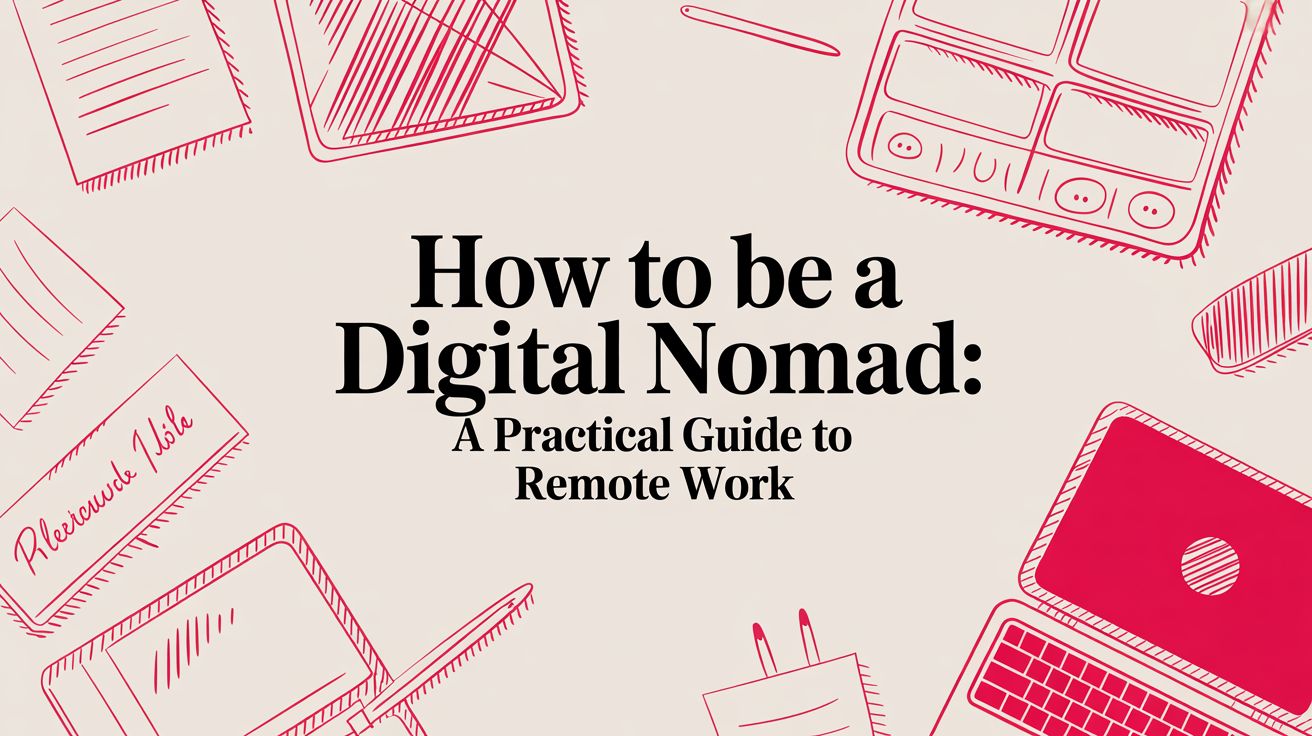9 Impactful Diversity Recruiting Strategies for 2025
Max
In today’s global, remote-first environment, building a diverse team isn’t just a moral imperative; it’s a critical business advantage. Companies that reflect the diversity of their customers are proven to be more innovative, resilient, and profitable. However, simply stating a commitment to diversity is not enough. Achieving genuine workforce diversity requires moving beyond generic platitudes and implementing intentional, data-driven diversity recruiting strategies. This is especially true for remote companies, which have an unprecedented opportunity to tap into talent pools unrestricted by geography.
This article moves past the buzzwords to deliver concrete, actionable methods for building a truly inclusive talent pipeline. We will break down nine powerful, practical, and remote-friendly strategies that go beyond surface-level efforts. For each strategy, you will find specific implementation steps, real-world examples, and expert insights to help you not only attract but also hire and retain talent from all backgrounds.
Whether you are just beginning your diversity, equity, and inclusion (DEI) journey or looking to refine your existing processes, these proven techniques provide a clear roadmap. From optimizing job descriptions to leveraging data and forging community partnerships, this guide is designed to help you build a high-performing team that is as diverse as it is talented. Get ready to transform your approach and see measurable results.
1. Blind Resume Screening
Blind resume screening is a powerful method designed to mitigate unconscious bias during the initial stages of the hiring process. This technique involves systematically removing or “blinding” personally identifiable information from resumes and applications before they are reviewed by hiring managers. Key details like names, photos, gender pronouns, age, specific dates, and even the names of prestigious universities are redacted.

The core principle is to force evaluators to focus exclusively on a candidate’s skills, experience, and qualifications. By stripping away demographic data that can trigger biases, this strategy ensures a more meritocratic review, giving every qualified applicant an equal opportunity to advance. This is one of the most direct and effective diversity recruiting strategies because it targets bias at a critical decision-making point.
How to Implement Blind Screening
Successfully adopting blind resume screening requires a structured approach. It isn’t just about blacking out names; it’s about creating a consistent and fair process.
Define Redaction Criteria: Clearly establish what information will be removed. Common elements include name, address, graduation years, and university names. Retain essential information like skills, work history, and accomplishments.
Use Technology: Manual redaction is time-consuming and prone to error. Leverage software solutions like those from Entelo or platforms like GapJumpers that automate the process or use skills-based challenges instead of traditional resumes.
Train Your Team: Ensure recruiters and hiring managers understand the why behind the process. Train them on how to evaluate candidates based purely on the anonymized data and structured criteria.
Start with a Pilot: Roll out blind screening for a specific department or a few key roles first. This allows you to measure its impact, gather feedback, and refine the process before a company-wide implementation.
The success of this strategy is well-documented. The London Symphony Orchestra famously increased its hiring of female musicians from 5% to nearly 50% after instituting blind auditions, a real-world parallel to blind resume screening. By focusing solely on talent, they dramatically diversified their orchestra.
2. Partnership with HBCUs and Minority-Serving Institutions
Forging long-term, strategic partnerships with Historically Black Colleges and Universities (HBCUs), Hispanic-Serving Institutions (HSIs), and other Minority-Serving Institutions (MSIs) is a proactive way to build a sustainable pipeline of diverse talent. This approach moves beyond simply attending a career fair and involves deeply integrating your company into the fabric of the institution through dedicated, year-round engagement.
These partnerships create a direct bridge to highly qualified candidates from underrepresented backgrounds. By investing in these institutions through scholarships, mentorship programs, sponsored research, and robust internship opportunities, companies can build trust and become an employer of choice. This is one of the most impactful diversity recruiting strategies because it addresses pipeline challenges at the source and fosters genuine, long-term relationships.
How to Implement Institutional Partnerships
Building a successful partnership requires commitment, authenticity, and a long-term vision. It’s about more than just transactional recruiting; it’s about mutual investment.
Start Small and Go Deep: Instead of a scattered approach, begin by building deep, meaningful relationships with two or three institutions. This allows you to understand their culture, needs, and academic strengths, creating a more effective and sustainable program before expanding.
Engage Year-Round: Don’t limit your presence to the fall recruiting season. Offer guest lectures, host workshops, sponsor student organizations, and provide mentors throughout the academic year to maintain visibility and build rapport.
Create Clear Pathways to Employment: Develop structured internship programs that provide meaningful, career-relevant experience and have a clear pathway to full-time offers. JPMorgan Chase invested heavily in its HBCU partnerships, resulting in a 40% increase in Black hires.
Leverage Alumni Networks: Involve alumni from these institutions who work at your company in your recruiting efforts. They serve as powerful role models and can offer authentic insights into your company culture.
This strategy extends beyond established institutions. Exploring the potential for national colleges for Latinos akin to HBCUs highlights emerging opportunities to connect with diverse talent pools. The success of programs like Google’s Howard West, which creates a satellite campus at Howard University, proves that deep, immersive partnerships yield exceptional results and cultivate the next generation of leaders.
3. Employee Referral Programs with Diversity Incentives
Traditional employee referral programs can inadvertently replicate a homogenous workforce, as people tend to refer others from similar backgrounds. Enhancing these programs with diversity incentives is a proactive strategy that encourages current employees to tap into broader, more diverse networks. This approach involves rewarding employees, often with higher bonuses, for successfully referring candidates from underrepresented groups.

The goal is to leverage your existing team’s connections while actively guiding them toward building a more inclusive talent pipeline. By creating a tangible reward system, you signal the company’s commitment to diversity and empower employees to become active partners in the effort. This is one of the more powerful diversity recruiting strategies because it mobilizes your entire organization, turning every employee into a potential diversity champion. Furthermore, engaged employees are more likely to participate, highlighting the importance of overall remote employee engagement.
How to Implement a Diversity Referral Program
Building an effective program goes beyond just offering a bonus; it requires a thoughtful, supportive structure that enables employees to succeed.
Offer Tiered Bonuses: Implement a system where the referral bonus is higher for a successfully hired candidate from an underrepresented group. This creates a clear, financial incentive for employees to broaden their search.
Partner with ERGs: Collaborate with your Employee Resource Groups (ERGs). These groups are natural hubs for diverse talent and can be powerful partners in sourcing candidates through their community and professional networks.
Provide Networking Training: Don’t assume employees know how to expand their professional circles. Offer workshops or resources that teach them how to network effectively in diverse communities, both online and offline.
Track and Celebrate Success: Use your HR software to monitor referral sources and diversity metrics. Publicly celebrate individuals and teams who contribute to diversity goals to encourage continued participation and create a sense of shared accomplishment.
Intel famously boosted its diverse referrals by 40% after introducing a tiered bonus structure. Similarly, Salesforce leverages its “Ohana Groups” (ERGs) to drive diverse referrals, integrating the initiative into its core company culture. These examples prove that with the right incentives and support, your employees can become your most effective tool for building a diverse team.
4. Inclusive Job Descriptions and Language Optimization
The language you use in your job postings is often the first point of contact a candidate has with your company, and it can either invite them in or push them away. Inclusive job descriptions involve a systematic review of job ads to remove biased language, unnecessary requirements, and other subtle barriers that can discourage qualified individuals from underrepresented groups from applying.
The goal is to create job descriptions that appeal to the widest possible audience by focusing on what truly matters: the core responsibilities and skills needed for the role. This strategy directly addresses potential biases before an application is even submitted, making it one of the most proactive diversity recruiting strategies available. It ensures that your talent pool isn’t unintentionally narrowed by exclusionary phrasing or unrealistic expectations. When crafting job descriptions, understanding the nuances of different tones of writing can significantly enhance their inclusivity and appeal to a broader candidate pool.
How to Optimize Your Job Descriptions
Creating truly inclusive job descriptions requires intentionality and a willingness to challenge old habits. It’s about clarity, precision, and welcoming language.
Audit Your Language: Use tools like Textio or Gender Decoder to analyze job descriptions for gender-coded words (e.g., “dominant,” “aggressive” vs. “collaborative,” “supportive”). Replace corporate jargon and aggressive superlatives like “rockstar” or “ninja” with clear, outcome-focused language.
Distinguish “Must-Haves” from “Nice-to-Haves”: Research shows that women, in particular, are less likely to apply for a job unless they meet 100% of the listed requirements. Clearly separate essential qualifications from preferred skills to encourage more candidates who have the core competencies to apply.
Focus on Impact, Not Pedigree: Instead of rigid requirements like “10+ years of experience” or a degree from a specific university, describe the outcomes you expect. For example, change “Requires a computer science degree” to “Requires proven ability to develop and ship complex software.”
Showcase Inclusive Benefits: Explicitly mention benefits that appeal to a diverse workforce, such as flexible work schedules, remote options, parental leave, and professional development stipends. This demonstrates a commitment to employee well-being and work-life balance, which can improve the candidate experience.
Companies that adopt this approach see tangible results. For example, Buffer reported a 42% increase in applications from women after revamping its job description language. Similarly, Atlassian broadened its talent pool by removing university degree requirements for many of its technical roles, focusing instead on demonstrated skill and potential.
5. Structured Interview Process and Diverse Interview Panels
A structured interview process is a standardized method of evaluating job candidates where all applicants are asked the same predetermined questions and assessed using a consistent, pre-set scoring rubric. When combined with diverse interview panels, this approach becomes one of the most effective diversity recruiting strategies for reducing interviewer bias and ensuring fair, competency-based evaluations. This dual strategy ensures that hiring decisions are based on merit, not an interviewer’s gut feeling or personal affinity.
The goal is to create a level playing field. A structured format prevents interviews from veering into territory that could reveal personal information susceptible to bias, while a diverse panel brings multiple viewpoints to the evaluation process. This combination minimizes the impact of any single individual’s unconscious biases, leading to more objective and equitable hiring outcomes. Google famously adopted this technique, championed by its People Operations team, and saw significant improvements in hiring quality and diversity.
How to Implement Structured and Diverse Interviews
Bringing structure and diversity to your interview process requires deliberate planning and company-wide commitment. It is more than just inviting different people to the meeting; it is about creating a rigorous evaluation framework.
Develop Competency-Based Questions: Create a set of questions that directly test the skills and competencies required for the role. Avoid hypothetical or brain-teaser questions in favor of behavioral ones (e.g., “Tell me about a time when…”). For more ideas, you can explore common remote job interview questions to build your list.
Build Diverse Panels: Intentionally assemble interview panels that include a mix of genders, ethnicities, departments, and seniority levels. This ensures a candidate’s abilities are reviewed from multiple angles.
Train Your Interviewers: All panel members must be trained on structured interviewing techniques, unconscious bias, and how to use the standardized rating scale. This ensures everyone is calibrated and evaluating candidates consistently.
Use Standardized Rating Scales: Implement a clear scoring rubric for every question. This forces interviewers to justify their ratings with specific evidence from the candidate’s answers, making the evaluation process more data-driven and less subjective.
Companies like Unilever and McKinsey & Company have successfully used these methods to diversify their talent pipelines. By focusing on objective criteria and incorporating varied perspectives, they have systematically improved representation and strengthened their teams.
6. Expanded Sourcing Channels and Diverse Job Boards
Relying solely on mainstream job boards limits your reach to a homogenous talent pool. To truly diversify your workforce, you must proactively seek out candidates where they are. This means expanding your sourcing channels to include diversity-focused job boards, professional associations, and online communities that cater specifically to underrepresented groups. This strategy is about intentionally casting a wider net into different talent ecosystems.
The goal is to move beyond passive job posting and engage in active, targeted outreach. By building authentic relationships with these platforms and organizations, you signal a genuine commitment to inclusion. This is one of the most proactive diversity recruiting strategies because it directly addresses the pipeline problem by bringing a more varied group of candidates into your hiring funnel from the very beginning. Learn more about how this integrates with a modern hiring approach by exploring remote talent acquisition strategies.
How to Implement Expanded Sourcing
Actively diversifying your sourcing requires research, relationship-building, and consistent effort. It’s about more than just posting a job and hoping for the best; it requires genuine engagement.
Identify Niche Platforms: Research and partner with job boards and professional networks relevant to your industry and the talent you seek. Examples include DiversityJobs, the National Society of Black Engineers (NSBE), Women in Technology (WIT), and the Professional Hispanic Network.
Build Authentic Relationships: Don’t just post and ghost. Engage with these communities by sponsoring events, participating in virtual career fairs, and sharing valuable content. The aim is to become a trusted employer brand within these networks.
Leverage Your Team: Ask your Employee Resource Groups (ERGs) for insights. They can recommend specific organizations, conferences, and online groups that are highly regarded within their communities.
Track Your ROI: Use your applicant tracking system (ATS) to monitor which channels deliver the most qualified and diverse candidates. This data will help you refine your strategy and allocate your recruitment budget effectively.
Major corporations have found great success by partnering with platforms like DiversityJobs.com and attending career fairs hosted by organizations like the Society of Hispanic Professional Engineers (SHPE). By showing up and investing in these spaces, they tap into rich talent pools that their competitors often overlook, making it a critical component of any comprehensive diversity and inclusion plan.
7. Return-to-Work and Career Re-entry Programs
Return-to-work programs are structured initiatives designed to help professionals re-enter the workforce after an extended career break. These “returnships” or re-entry programs specifically target talented individuals who stepped away for reasons like caregiving, military service, or personal health, and provide a supported pathway back into their fields. They often include mentorship, skills training, and flexible work arrangements to ease the transition.
This strategy directly taps into a highly skilled, yet often overlooked, talent pool. Professionals on career breaks, predominantly women, possess immense experience and a mature perspective. By creating a formal on-ramp, companies can attract these dedicated individuals and significantly enhance gender, age, and experiential diversity. This is one of the most impactful diversity recruiting strategies because it addresses a systemic barrier that disproportionately affects caregivers.
How to Implement a Career Re-entry Program
Building an effective returnship requires more than just an open job posting; it demands a supportive infrastructure that sets participants up for long-term success.
Structure a Formal Program: Design a fixed-term program (e.g., 12-16 weeks) that functions like an internship for experienced professionals. Offer a clear path to a full-time role upon successful completion. Define projects that allow participants to demonstrate their skills and learn new ones.
Partner with Specialized Organizations: You don’t have to start from scratch. Collaborate with nonprofits like Path Forward or consulting firms like iRelaunch. These organizations help companies design, recruit for, and manage high-impact return-to-work programs.
Provide Comprehensive Support: Offer dedicated mentorship from employees who may have had similar experiences. Incorporate upskilling modules to refresh technical knowledge and familiarize returnees with current industry tools and processes.
Offer Flexibility: Acknowledge that many returnees are balancing ongoing personal responsibilities. Build in flexible scheduling, remote work options, or part-time arrangements to make the transition manageable and sustainable.
Pioneered by programs like Goldman Sachs’ ‘Returnship’ and General Motors’ ‘Relaunch’, this model has proven its value. These initiatives not only fill critical roles with experienced talent but also foster a more inclusive culture that recognizes non-linear career paths as a source of strength.
8. Data-Driven Diversity Analytics and Bias Interruption
Leveraging data-driven analytics is a sophisticated strategy for identifying and actively correcting bias within the recruitment lifecycle. This approach involves the systematic use of data, analytics, and sometimes artificial intelligence to pinpoint where diverse candidates are dropping out of the hiring funnel and to implement targeted interventions. By tracking metrics in real-time, companies can move from reactive measures to proactive, data-informed decisions.
The core idea is to treat diversity recruiting like any other critical business function: measure it, analyze it, and continuously improve it. Tools like Pymetrics, which uses AI-powered behavioral assessments, or Textio, which analyzes job descriptions for biased language, help automate this process. This transforms the complex challenge of equity into a manageable, measurable goal, making it one of the most impactful diversity recruiting strategies for modern organizations.
How to Implement Diversity Analytics
Adopting a data-first approach requires a clear framework and commitment to transparency. It’s about building systems that hold the organization accountable for its diversity goals.
Establish Baseline Metrics: Begin by analyzing your current recruitment funnel. Track the demographic breakdown of candidates at every stage: application, screening, interview, offer, and hire. This baseline reveals your biggest areas for improvement.
Utilize HR Technology: Implement tools that provide diversity dashboards and analytics. Platforms like Greenhouse or Workday offer robust reporting features that can track progress against DEI goals and highlight potential bias hot spots.
Conduct Regular Bias Audits: Regularly audit any AI or automated systems you use for recruitment to ensure they are not perpetuating bias. Combine this quantitative data with qualitative feedback from diverse candidates to get a complete picture. To further understand how to identify and mitigate biases, consider insights on unconscious bias in recruitment and fair hiring strategies.
Create Accountability: Tie diversity metrics to leadership performance reviews. When leaders are directly accountable for progress in their departments, data shifts from a passive report to an active driver of change. This is especially vital in building equitable practices for a distributed team, which you can explore further in our guide to remote workforce management.
IBM provides a strong example by using its own Watson AI to analyze recruitment data, identifying patterns that could indicate bias and helping its talent acquisition teams make more equitable decisions at scale. By turning data into actionable insights, they actively interrupt bias before it can derail their diversity efforts.
9. Community Outreach and Grassroots Engagement
Community outreach and grassroots engagement is a long-term strategy focused on building authentic, lasting relationships with diverse communities. Rather than waiting for candidates to apply, this approach involves proactively connecting with local organizations, community centers, professional meetups, and coding bootcamps to build a talent pipeline from the ground up. This method goes beyond simple recruitment and aims to create genuine partnerships.
The core principle is to establish trust and become a visible, supportive presence within underrepresented communities. By offering value through mentorship, skills training, and event sponsorship, companies can organically attract talent that might otherwise be unaware of their opportunities. This is one of the most impactful diversity recruiting strategies because it addresses systemic barriers at their source, building a sustainable flow of diverse candidates.
How to Implement Community Outreach
Effective community engagement requires authenticity, consistency, and a focus on mutual benefit, not just immediate hiring goals.
Build Authentic Relationships First: Prioritize getting to know community leaders and their needs before making any recruitment asks. Attend their events, offer support, and listen to their goals.
Partner with Established Organizations: Instead of starting from scratch, collaborate with existing community groups, non-profits, or educational institutions like bootcamps that already have trust and influence. Microsoft’s TEALS program, which brings computer science education to high schools, is a prime example of this.
Empower Employee Ambassadors: Engage employees from similar backgrounds to act as community ambassadors. Their personal stories and experiences are more authentic and relatable than a corporate recruiter’s pitch.
Provide Tangible Value: Offer free workshops, mentorship programs, or tech resources. Your goal should be to uplift the community, which in turn builds your employer brand and attracts mission-aligned talent.
Measure Both Impact and Hires: Track traditional recruiting metrics like hires, but also measure community impact metrics such as the number of people trained, events supported, and long-term relationships built.
Diversity Recruiting Strategies Comparison
Strategy | Implementation Complexity 🔄 | Resource Requirements ⚡ | Expected Outcomes 📊 | Ideal Use Cases 💡 | Key Advantages ⭐ |
|---|---|---|---|---|---|
Blind Resume Screening | Medium - requires software/manual setup | Moderate - software tools or manual effort | Reduces unconscious bias; improves diversity | Initial resume screening; merit-based evaluations | Fair hiring; increases diversity; legally defensible |
Partnership with HBCUs and Minority-Serving Institutions | High - long-term relationship building | High - ongoing engagement and resources | Sustainable diverse talent pipelines | Building diverse early talent pipelines; internships | Access to qualified diverse pools; brand building |
Employee Referral Programs with Diversity Incentives | Medium - program design and tracking | Moderate - bonuses and training | Higher diverse referrals; improved retention | Large organizations leveraging employee networks | Cost-effective; scalable; engages employees |
Inclusive Job Descriptions and Language Optimization | Low - review and update processes | Low - minimal technology or tools | More diverse applicants; improves employer brand | Early recruitment stages; job ad improvement | Quick wins; removes barriers; measurable impact |
Structured Interview Process and Diverse Interview Panels | High - training and coordination | High - interviewer training and panel setup | Reduces interviewer bias; improves hiring quality | Interview stage; competency and bias-controlled selection | Consistent evaluation; legally defensible; inclusive environment |
Expanded Sourcing Channels and Diverse Job Boards | Medium - building and managing partnerships | Moderate - relationship building and outreach | Access to untapped diverse talent pools | Sourcing diverse candidates beyond traditional platforms | Expands candidate pool; cost-effective; community engagement |
Return-to-Work and Career Re-entry Programs | High - program management and HR support | High - training, mentorship, flexible roles | Increases gender and age diversity | Supporting professionals returning after career breaks | High retention; fills skill gaps; shows flexibility |
Data-Driven Diversity Analytics and Bias Interruption | High - tech implementation and analysis | High - technology and data expertise | Identifies and reduces bias systematically | Large organizations focused on evidence-based D&I actions | Objective insights; rapid bias correction; scalable |
Community Outreach and Grassroots Engagement | High - ongoing community relationship building | High - time and authentic engagement | Builds long-term pipelines; improves brand | Local community engagement; non-traditional talent sourcing | Genuine relationships; social responsibility; diverse talent |
From Strategy to Culture: Embedding Diversity in Your Hiring DNA
Embarking on a mission to enhance your organization’s diversity is not merely about ticking boxes or meeting quotas. The journey we have explored through strategies like blind resume screening, structured interviews, and inclusive language is about fundamentally re-engineering your company’s approach to talent acquisition. These are not isolated tactics but interconnected components of a holistic ecosystem designed to attract, hire, and retain a workforce that truly reflects the rich diversity of our global community.
Moving beyond the checklist mentality is the most critical step. Implementing these diversity recruiting strategies is a powerful start, but the ultimate goal is to weave them so deeply into your operational fabric that they become second nature. True success is realized when inclusive hiring isn’t a separate, resource-intensive initiative but simply “the way we hire.” This transformation from a set of actions to an ingrained cultural value is where sustainable change happens.
Synthesizing Strategy into Lasting Impact
As you reflect on the methods discussed, from partnering with Minority-Serving Institutions to leveraging data for bias interruption, recognize that they share a common thread: intentionality. Unconscious bias thrives in ambiguity and unstructured processes. By deliberately designing your hiring funnel to be more objective, equitable, and accessible, you systematically dismantle the barriers that have historically excluded underrepresented talent.
Consider the key takeaways from our deep dive:
Structure is Your Ally: Unstructured interviews and vague job descriptions open the door for bias. Implementing structured interview processes with diverse panels and optimizing job descriptions for inclusive language creates a level playing field where skills and potential can shine.
Expand Your Horizons: Relying on the same old sourcing channels will yield the same old results. Actively expanding to diverse job boards, engaging with community organizations, and building relationships with institutions like HBCUs are non-negotiable for reaching new talent pools.
Data Drives Accountability: You cannot improve what you do not measure. Establishing clear diversity analytics and using them to identify and interrupt bias in your pipeline is essential for making informed decisions and holding your organization accountable for its goals.
Your Action Plan for an Inclusive Future
Translating these insights into action requires a clear, phased approach. Don’t try to implement everything at once. Instead, start with a few high-impact strategies that address your organization’s most significant gaps. Perhaps you begin by launching a pilot program for blind resume screening or by training your hiring managers on conducting structured, competency-based interviews.
As you implement these changes, remember that this is an iterative process. Continuously gather feedback from candidates and new hires, analyze your hiring data, and refine your approach. The work of building a diverse and inclusive culture is never truly “done.” It requires persistent effort, unwavering commitment from leadership, and a willingness to challenge long-standing norms. The reward for this commitment is immense: a more innovative, resilient, and high-performing organization that is better equipped to solve complex problems and thrive in the modern, remote-first world.
Remember, diversity is the catalyst, but inclusion is the culture that makes it stick. By mastering these diversity recruiting strategies, you are not just changing how you hire; you are building a workplace where every individual feels a genuine sense of belonging and is empowered to contribute their unique perspective. This is the ultimate competitive advantage.
Ready to put these strategies into action and connect with a diverse, global talent pool? Post your next remote role on Remote First Jobs to reach skilled professionals from different backgrounds and locations who are actively seeking inclusive, remote-first companies. Start building your representative team today at Remote First Jobs.


